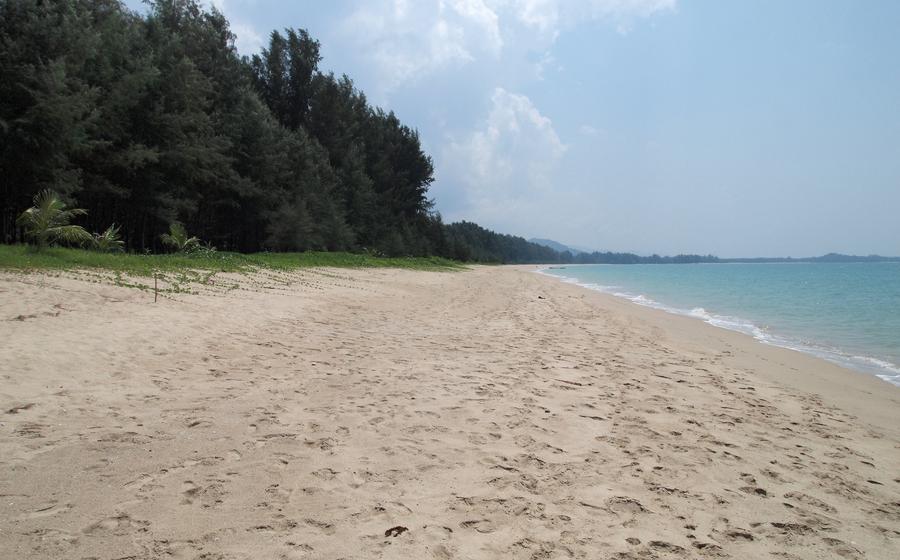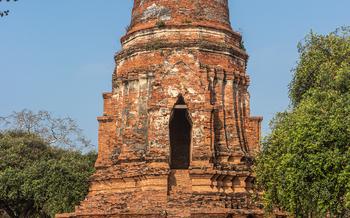
Little Amazon Takuapa
- Boat Tours and Kayaking: Exploring the Takuapa River
- Boat Tours
- Kayaking
- Local communities along the river
- Mangrove Forests: A Natural Wonder
- Rubber Plantations: A Legacy of the Past
- Elephant Sanctuary: A Haven for Gentle Giants
- Seafood Delights: A Taste of the Sea
- Local Handicrafts: A Touch of Tradition
- Festivals and Events: A Celebration of Culture
- Getting to Takuapa: A Seamless Journey
- Insider Tip: Explore by Bicycle
Boat Tours and Kayaking: Exploring the Takuapa River
The Takuapa River is a picturesque waterway that offers visitors a chance to immerse themselves in the natural beauty of the region. Boat tours and kayaking are popular activities that allow visitors to explore the river's tranquil waters, lush mangrove forests, and traditional fishing villages.
Boat Tours
Boat tours on the Takuapa River are a great way to see the river's highlights and learn about its history and culture. Tours typically last for several hours and include stops at various points of interest, such as the mangrove forests, the floating market, and the Takuapa Old Town. Visitors can choose from a variety of boat tour options, including small motorized boats, traditional longtail boats, and even kayaks.
Kayaking
For a more adventurous experience, visitors can rent kayaks and explore the Takuapa River at their own pace. Kayaking is a great way to get up close and personal with the river's natural beauty and wildlife. Visitors can paddle through the mangrove forests, spot birds and other wildlife, and visit local villages along the riverbank.
Local communities along the river
The Takuapa River is home to several local communities, each with its unique culture and traditions. One of the most fascinating communities is the Chao Ley, also known as the "Sea Gypsies." These nomadic people have lived on and around the river for centuries, relying on fishing and other water-based activities for their livelihood. Their colorful boats, traditional houses, and unique lifestyle make them a must-see for any visitor to Takuapa.
Another notable community along the river is the Moken, who are also skilled fishermen and boat builders. They are known for their intricate tattoos, which they believe protect them from harm while diving for pearls and other marine resources. Visitors can interact with these communities and learn about their way of life by visiting their villages, taking boat tours, or simply observing them as they go about their daily activities.
Mangrove Forests: A Natural Wonder
Takuapa's mangrove forests are a sight to behold, stretching along the coastline and forming a unique and diverse ecosystem. These forests play a vital role in protecting the region from erosion and storm surges, acting as a natural barrier against the powerful forces of the sea. The dense roots of the mangrove trees help to stabilize the coastline, preventing soil erosion and safeguarding the delicate balance of the ecosystem.
As you venture into these remarkable forests, you will encounter a variety of mangrove species, each adapted to the unique conditions of this environment. The most common species include the red mangrove, the black mangrove, and the white mangrove, each with its distinct characteristics and adaptations.
These mangrove forests serve as a critical habitat for a diverse array of wildlife, including fish, crustaceans, and birds. The intricate root systems provide shelter and breeding grounds for numerous species, contributing to the overall biodiversity of the region. The forests also act as a natural filtration system, helping to purify water and remove pollutants from the surrounding environment.
Rubber Plantations: A Legacy of the Past
Takuapa has a rich history intertwined with rubber plantations, a legacy of the past that has left an indelible mark on the region. During the early 20th century, rubber plantations flourished in Takuapa, driven by the global demand for natural rubber. These plantations were established by Chinese immigrants who brought their expertise and labor to cultivate the rubber trees. The rubber industry brought prosperity to the region, transforming Takuapa into a thriving economic hub.
Visitors to Takuapa can immerse themselves in this fascinating history by visiting the Rubber Plantation Museum. This museum showcases the history and process of rubber tapping, providing insights into the lives of the plantation workers and the economic significance of rubber to the region. The museum also offers guided tours of an actual rubber plantation, where visitors can witness the tapping process firsthand.
A visit to the rubber plantations offers a glimpse into a bygone era, shedding light on the region's rich agricultural heritage. It is a unique opportunity to learn about the history of rubber production and its impact on the development of Takuapa.
Elephant Sanctuary: A Haven for Gentle Giants
Takuapa is home to a remarkable elephant sanctuary that offers visitors a unique opportunity to connect with these majestic creatures in a responsible and ethical way. The sanctuary is dedicated to providing a safe haven for rescued elephants, allowing them to roam freely in a natural environment and receive the care and attention they need.
Visitors to the sanctuary can embark on an educational and interactive experience, learning about the fascinating behavior and ecology of elephants. Guided tours take visitors through the sanctuary, where they can observe the elephants interacting with each other and their surroundings. There are also opportunities to feed the elephants and even bathe them in the nearby river, creating a truly unforgettable and heartwarming experience.
Elephant trekking is another popular activity at the sanctuary, allowing visitors to explore the surrounding jungle atop these gentle giants. However, it's important to note that elephant trekking is a controversial practice, and some animal welfare organizations advise against it. It's crucial to choose a sanctuary that prioritizes the well-being of the elephants and ensures that they are not subjected to any form of abuse or mistreatment.
Takuapa's elephant sanctuary is a must-visit for anyone who loves animals and wants to learn more about these incredible creatures. By supporting this sanctuary, visitors can contribute to the conservation of elephants and help protect these gentle giants from extinction.
Seafood Delights: A Taste of the Sea
Takuapa is a paradise for seafood lovers, with an abundance of fresh catches from the Andaman Sea. From succulent prawns to meaty lobsters, the variety of seafood available is sure to tantalize your taste buds.
Popular seafood dishes to try: - Tom Yum Goong: A spicy and sour soup featuring succulent prawns, mushrooms, and lemongrass. - Gaeng Som Pla: A flavorful curry made with fresh fish, vegetables, and a tangy broth. - Phad Prik King: Stir-fried vegetables tossed with chili paste and your choice of seafood.
Recommended seafood restaurants in Takuapa: - Ruen Mai: A beachfront restaurant with stunning sunset views and a wide selection of seafood dishes. - Baan Talay: A family-run restaurant known for its authentic Thai seafood cuisine. - Samakee Seafood: A casual eatery serving up fresh seafood at affordable prices.
Local Handicrafts: A Touch of Tradition
The vibrant local handicrafts of Takuapa reflect the town's rich cultural heritage. Artisans in Takuapa specialize in various traditional crafts, including batik painting, woodcarving, and pottery.
Colorful batik fabrics adorned with intricate patterns are a popular souvenir among visitors. Skilled artisans use a wax-resist dyeing technique to create these vibrant textiles.
Woodcarving is another cherished craft in Takuapa. Artisans transform ordinary pieces of wood into intricate sculptures depicting animals, mythical creatures, and scenes from everyday life.
Pottery is also a significant part of the local handicraft tradition. Artisans create beautiful ceramic pieces, such as vases, bowls, and plates, using traditional techniques passed down through generations.
Visitors to Takuapa can find these handcrafted treasures at the local markets, where artisans showcase their creations. Supporting local artisans by purchasing their products not only contributes to the preservation of traditional crafts but also supports the local economy.
Festivals and Events: A Celebration of Culture
Takuapa comes alive during its vibrant festivals and events, offering a glimpse into the town's rich cultural heritage. The most notable celebration is the Takuapa Seafood Festival, held annually in April, which showcases the region's culinary delights, particularly its fresh seafood. Visitors can indulge in a variety of dishes, cooking demonstrations, and live entertainment.
Another significant event is the Takuapa Loy Krathong Festival, held in November, where locals and tourists gather to release beautifully decorated krathongs (floating baskets) into the Takuapa River, accompanied by fireworks and traditional performances. This festival symbolizes letting go of negative emotions and bad luck while making wishes for good fortune.
To immerse yourself in the local culture, don't miss the Takuapa Temple Fair, held at Wat Khao Takuapa during Songkran (Thai New Year) in April. This lively festival features merit-making ceremonies, traditional music and dance performances, food stalls, and games.
These festivals and events provide a wonderful opportunity to experience the warmth and hospitality of the Takuapa community, while celebrating the town's unique traditions and customs. Embrace the festive spirit and join in the celebrations to create lasting memories of your time in Takuapa.
Getting to Takuapa: A Seamless Journey
Reaching Takuapa is a breeze, with multiple transportation options available from major cities in Thailand. Whether you prefer the convenience of air travel, the scenic charm of a train ride, or the flexibility of a bus journey, there's a mode of transport that suits every traveler.
For those seeking a quick and comfortable journey, flights from Bangkok to Phang Nga Airport (also known as Takuapa Airport) take approximately 1 hour and 15 minutes. From the airport, a short taxi or tuk-tuk ride will whisk you to your desired destination in Takuapa.
If you prefer a more leisurely and scenic route, hop on a train from Bangkok's Hua Lamphong Railway Station to Takuapa Railway Station. The journey takes around 12 hours, but the panoramic views of the countryside and the chance to interact with locals make it a worthwhile experience.
For budget-conscious travelers, buses offer a cost-effective way to reach Takuapa. Several bus companies operate daily services from Bangkok's Southern Bus Terminal to Takuapa Bus Station. The journey takes approximately 10 hours, but the comfortable reclining seats and air-conditioning ensure a relatively comfortable ride.
To ensure a smooth and hassle-free journey, it's advisable to book your transportation in advance, especially during peak tourist seasons. Online booking platforms and travel agents can assist with reservations and provide information on schedules and fares. With its excellent connectivity and range of transportation options, getting to Takuapa is a breeze, allowing you to embark on your adventure without any worries.
Insider Tip: Explore by Bicycle
Cycling is an excellent way to explore Takuapa and its surrounding areas at your own pace. The town is relatively flat, making it easy to navigate on a bicycle. You can cycle along the scenic Takuapa River, through the lush mangrove forests, and to the beautiful Takuapa Beach. There are several bike rental shops in Takuapa where you can rent a bicycle for a day or longer. When cycling in Takuapa, remember to wear a helmet and be mindful of traffic. You can also join guided bike tours to explore the town and its surroundings with a local guide.




